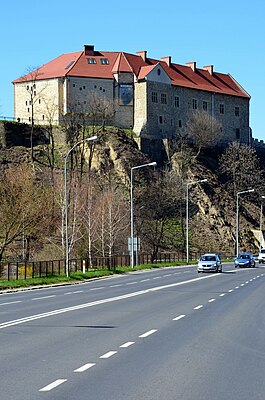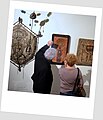Sanoker Royal Castle
| Sanoker Royal Castle | ||
|---|---|---|
|
The castle seen from Landesstrasse 28 . |
||
| Alternative name (s): | Queen Bona Castle; Castle Seat of the Starosts The upper court of German law at Sanok Castle (1425–1553) | |
| Creation time : | around 1366 | |
| Castle type : | Hilltop castle | |
| Conservation status: | modification | |
| Standing position : | Royal Castle | |
| Place: | Sanok | |
| Geographical location | 49 ° 33 '44 " N , 22 ° 12' 33" E | |
| Height: | 317 m npm | |
|
|
||
The Sanok Royal Castle ( Polish: Zamek Królewski w Sanoku ) is located in the city center of Sanok , only 100 m from the market square , at Zamkowagasse 1 on the high bank of the San . The former wooden castle, which was converted into a Renaissance castle in the middle of the 16th century, now houses the city's historical museum. It is the main attraction of Sanok.
The place was mentioned in writing for the first time in 1150, but it was not until 1339 that Georg II gave it city rights. On May 2, 1417, the Polish king Władysław II. Jagiełło married in the parish church of Sanok Elisabeth von Pilitza . After Wladyslaw's death in 1434, his last wife, Sophie Holszańska , retired to Sanok Castle. In 1523–1548 the Gothic castle was rebuilt in the Renaissance style . In 1549 another fire struck the city. In 1566, a great fire broke out and eventually left almost the entire city to rubble and ashes.
Magdalena Grzebałkowska at the opening of the book “ Beksińscy” . (2014)
Historical museum in Sanok
A collection of icons is shown on several floors, and works by the contemporary artist Zdzisław Beksiński , born in Sanok, are on display on the top floor . In his will, Zdzisław Beksiński bequeathed all of his artistic oeuvre to the Historical Museum in Sanok, to which he had already given around 300 works during his lifetime. After the artist's death, the museum received around 20 of his last paintings, around a thousand photos and graphics, as well as all of his assets: apartments, bank facilities, computer equipment. The museum's collections were also expanded to include multimedia recordings, letters or films documenting the family life of the creator. The museum currently has the largest collection of the artist's works, comprising a few thousand pictures, reliefs, sculptures, drawings, graphics and photographs. In 2010 the Zdzisław Beksinski Gallery of Modern Art in Sanok was founded by the Polish Minister for Regional Development. The gallery is the only one of its kind in Europe and was the first in the world to open on May 19, 2012. Interesting is the icon collection in Sanok Castle, all icons that were made in south-eastern Poland between the 14th and 20th centuries, as well as the open-air museum in the Biała-Góra district , which is the only Ruthenian icon collection in Poland - after Saint Petersburg and Kiev the largest collection - owns.
gallery
Janusz Szuber . Literature meeting at the castle
See also
Web links
Individual evidence
- ↑ Sąd wyższy prawa niemieckiego na zamku sanockim (1425-1553). Samolewicz 1903
- ↑ "of the arrival of the Hungarian army in Przemysl; King Géza II moved over the mountains , seized the town of Sanok -" went over the mountains and took the Sanok Castle. "In: Hungarian Review. B. 11 op. Cit. Hypatius Chronicle
- ↑ "With a few exceptions, German town law in Poland had applied to German and Polish citizens from the start. In Rotussia, George II had protected the" Hungarians, Germans, Poles and Rotreussians " in 1339 when Sanok was founded. ..] "In 1376 he (Opole Wladislaus II. ) Laid out a German town west of Sanok." In: Walter Kuhn : History of the German East Settlement in Modern Times. Part 2
- ^ Yearbook of Austrian Byzantine Studies. B. 31, part. 1, 1981.
- ^ Scientific service for East Central Europe. B. 9.








